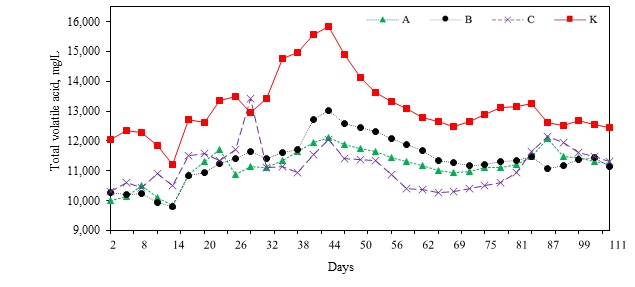Effect of Hyphomicrobium sp. in Biogas Formation from Organic Waste Treated by Batch Mode Anaerobic Digestion DOI: 10.32526/ennrj.18.3.2020.24
Main Article Content
Abstract
Huge consumption of fossil fuel energy creates environmental problems, while the amount of organic solid waste is in an increasing trend especially in developing countries. Biogas is known as a renewable energy that can be used as an alternative fuel which is promising to reduce dependency on fossil fuels. This study identified the concentration of methane gas that can be produced from organic waste treated in an anaerobic digestion with the addition of Hyphomicrobium sp. Two-stage batch anaerobic digestion was used with an operational volume of 6 L. Four different starting concentrations of bacteria Hyphomicrobium sp. added to the reactors: 0.29 × 109 cells/L in reactor A, 0.87 × 109 cells/L in reactor B, 1.75 × 109 cells/L in reactor C, and no Hyphomicrobium sp. in the control reactor. The results showed that the concentration of methane gas produced was 38.4% in the reactor A while in reactor B and C were 35.6% and 33%, respectively. In reactor K with no addition of bacteria, the amount of methane produced was 52%. In contrary to the hypothesis, the addition of Hyphomicrobium sp. to the anaerobic process was contra-productive to the yield of methane. Further research is required to investigate the role of Hyphomicrobium sp. on the methane gas formation in the reactor.
Article Details
Published articles are under the copyright of the Environment and Natural Resources Journal effective when the article is accepted for publication thus granting Environment and Natural Resources Journal all rights for the work so that both parties may be protected from the consequences of unauthorized use. Partially or totally publication of an article elsewhere is possible only after the consent from the editors.
References
2. Economist Intelligence Unit (EIU). Fixing Food: Towards a More Sustainable Food System [Internet]. 2017 [cited 2020 Jan 30]. Available from: https://foodsustainability.eiu.com/wp-content /uploads/sites/34/2017/03/FIXING-FOOD-TOWARDS-A-MORE-SUSTAINABLE-FOOD-SYSTEM.pdf.
3. Gotaas HB. Composting, Sanitary Disposal and Reclamation of Organic Wastes. Geneva: WHO Nanograph Series No 31; 1956.
4. Grady Jr. CPL, Lim HC. Biological Wastewater Treatment. New York, USA: Marcel Dekker Inc.; 1990. p. 29.
5. Hayes D, Thomas IH, Ronald R, Frank RJ. Production of High Methane Content Product by Two Phase Anaerobic Digestion. USA: Gas Research Institute; 1988.
6. Ilaboya IR, Asekhame FF, Ezugwu MO, Erameh AA, Omofuma FE. Studies on Biogas Generation from Agricultural Waste; Analysis of the Effects of Alkaline on Gas Generation. World Applied Sciences Journal 2010;9(5):537-45.
7. Jeong SY, Kim TG. Development of a novel methanothropic process with the helper microorganism Hyphomicrobium sp. NM3. Journal of Applied Microbiology 2019;126(2):534-44.
8. Liberty L, Prayatni S. The Effect of Adding Water to the CNP Ratio of Biowaste in a Mechanical Biological Treatment [dissertation]. Bandung: Bandung Institute of Technology; 2008.
9. Mao C, Feng Y, Wang X, Ren G. Review on research achievements of biogas from anaerobic digestion. Renewable and Sustainable Energy Reviews 2015;45:540-55.
10. Malina Jr., Joseph F, dan Pohland GF. Design of Anaerobic Processes For The Treatment Of Industrial and Municipal Wastes. USA: Technomic Publishing Co, Inc; 1992. p. 153.
11. Marin A, Denimal E, Guyot S, Journaux L, Molin P. A robust generic method for grid detection in White Light Microscopy Malassez Blade Images in the context of cell counting. Microscopy and Microanalysis 2014;21(1):239-48.
12. Naik SN, Goud VV, Rout PK, Dalai AK. Production of first and second generation biofuels: A comprehensive review. Renewable and Sustainable Energy Reviews 2010;14(2):578-97.
13. Noraini M, Sanusi SMA, Elham OSJ. Factors affecting production of biogas from organic solid waste via anaerobic digestion process: A review. Solid State Science and Technology 2017;25(1):29-39.
14. Rahayu NS. The Performance of Upflow Anaerobic Fixed Bed (UAFB) Reactor for Organic Removal in Solid Waste under Liquid Phase without pH Adjustment [dissertation]. Bandung: Bandung Institute of Technology; 2011.
15. Ramadanthi GP. Degradation of Liquid Phase Organic Waste Using Batch Mode Anaerobic Digestion [dissertation]. Bandung: Bandung Institute of Technology; 2008.
16. Ramos-Suárez J, Arroyo NC, González-Fernández C. The role of anaerobic digestion in algal biorefineries: Clean energy production, organic waste treatment, and nutrient loop closure. In: Singh B, Kuldeep B, Faizal B, editors. Algae and Environmental Sustainability. India: Springer; 2015. p. 53-76.
17. Rees JF. The fate of carbon compounds in the landfill disposal of Organik Matter. Journal of Chemical Technology and Biotechnology 1980;30:25-36.
18. Syafila M, Djajadiningrat A. Performance of hybrid anaerobic digestion with rock stone to treat molase contained waste water. Proceedings of ITB Science and Technology: 2003; Bandung, Indonesia: ITB Publisher; 2003.
19. Tchobanoglous GB. Wastewater Engineering: Treatment, Disposal, and Reuse. New York, USA: McGraw-Hill, Inc.; 2004.
20. Utami A. Organic Waste Removal in Slurry Phase Treated in an Anaerobic Digestion Reactor [dissertation]. Bandung: Bandung Institute of Technology; 2010.
21. Veenstra S, Lubberding HJ. Anaerobic Wastewater Treatment. Delf, Netherland: International Institute for Infrastructural Hydraulic and Environmental Engineering (IHE); 1993.
22. Widjajanti S. Treatment of Waste Water from Security Printing Using Anaerobic Biological Process of Circulating Bed Reactor (CBR) with Sequencing Batch Reactor (SBR) System [dissertation]. Bandung: Bandung Institute of Technology; 2008.
23. Wilkie AC. Biomethane from biomass, biowaste, and biofuels. In: Wall J, Harwood C, Demain A, editors. Bioenergy. Washington DC, USA: ASM Press; 2008. p. 195-205.
24. Wilkinson TG, Hamer G. Some growth characteristics of a Hyphomicrobium sp. in batch culture. Journal of Applied Bacteriology 1972;35:577-88.
25. Wilkinson TG, Harrison DEF. The affinity methane and methanol of mixed cultures grown on methane in continuous culture. Journal of Applied Microbiology 1973;36:309-13.
26. Wongthanate J, Mongkarothai K. Enhanced thermophilic bioenergy production from food waste by a two-stage fermentation process. International Journal of Recycling of Organic Waste in Agriculture 2018;7:109-16.

